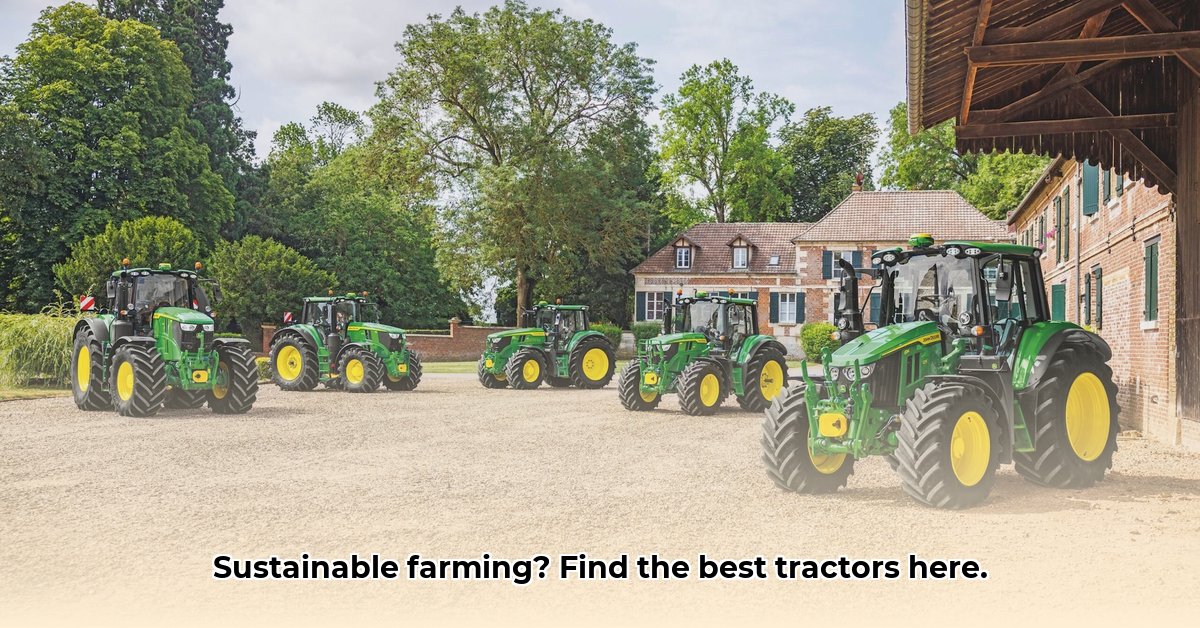
Choosing the right tractor is a pivotal decision for sustainable agriculture, impacting productivity, profitability, and environmental responsibility. This guide provides actionable steps for selecting, maintaining, and utilizing tractors to optimize your farming operation. For help determining the right size, check out this helpful resource on tractor sizing.
Tractor Quality: Matching Tractors to Sustainable Farming Goals
Selecting a tractor involves more than just brand recognition. Factors like farm size, local dealer support, and specific farming practices significantly influence the optimal choice. While John Deere, Kubota, and Mahindra are leading brands, their suitability varies depending on individual needs. A compact tractor ideal for smaller plots might prove inefficient for large-scale operations. What constitutes "good" tractor quality for sustainable farming extends beyond simple reliability.
Key Attributes of Sustainable Tractors
Sustainable farming prioritizes responsible resource management. In tractor selection, this translates to:
Fuel Efficiency: Lower fuel consumption directly reduces operating costs and minimizes a farm's carbon footprint. The goal is to find the optimal balance between power and economy. Lower fuel consumption translates into significant cost savings over a tractor's operating life.
Parts Availability & Dealer Support: Prompt access to parts minimizes costly downtime, which is crucial during peak seasons like harvest. A strong local dealer network offers immediate support, reducing delays and boosting overall efficiency. Prompt maintenance prevents major issues.
Attachment Versatility: Tractors capable of utilizing diverse attachments (e.g., plows, tillers, sprayers) provide flexibility and efficiency. This minimizes the need for multiple specialized machines, reducing both capital investment and storage space.
Technological Integration: Precision farming technologies like GPS guidance improve accuracy, minimizing overlaps and reducing the overuse of fertilizers, pesticides, and fuel. Data-driven decision-making optimizes resource allocation.
Your Step-by-Step Tractor Buying Guide
Acquiring a tractor demands careful planning. This structured approach streamlines the process:
Assess Farm Needs: Analyze acreage, soil type, farming practices, and crop types. This initial assessment defines the required tractor size and capabilities. Accurate assessment is crucial for efficient tractor selection.
Thorough Research: Extend research beyond marketing materials. Explore independent reviews from other farmers; compare specifications across various makes and models to determine the best fit. Don't rely solely on reputation; explore real-world experiences.
Verify Local Dealer Support: Directly engage with local dealerships. Inquire about parts availability, servicing capabilities, and typical response times. Robust dealer support is crucial for minimizing costly downtime. A responsive dealer is invaluable.
Analyze Total Cost of Ownership (TCO): Factor in fuel consumption, expected maintenance, potential repairs, and eventual resale value. The long-term economic impact of the tractor is essential for financial sustainability. TCO must be carefully considered.
Conduct a Test Drive (When Feasible): Hands-on experience verifies operator comfort and control familiarity. A test drive helps identify potential ergonomic issues or control limitations. Familiarize yourself with the tractor's operation.
Understanding Tractor Risks: Brand-Specific Challenges & Mitigation
Potential issues vary across brands. Effective mitigation strategies are crucial to ensure long-term productivity and minimize disruptions:
| Brand | Potential Issue | Likelihood | Severity | Mitigation |
|---|---|---|---|---|
| John Deere | Rear housing durability (aluminum) | Moderate | Moderate | Invest in heavier-duty models; implement a proactive maintenance schedule. |
| Kubota | Ergonomics (e.g., pedal placement) | Low | Low | Conduct a thorough test drive before purchasing; ensure proper operator fit. |
| Mahindra | Past supply chain inconsistencies | Low | Moderate | Verify current parts availability and dealer responsiveness before purchase. |
| All Brands | Unexpected mechanical failure | Low | High | Regular preventive maintenance is essential; consider insurance coverage; develop backup plans. |
The Future of Tractors and Sustainable Farming
Environmental regulations are driving innovation in tractor design. Fuel efficiency and emissions standards are constantly evolving, influencing both tractor costs and operational expenses. Staying informed about these trends is vital for long-term agricultural success. Staying updated on industry advancements is crucial.
How to Choose the Most Fuel-Efficient Tractor for Sustainable Farming:
Key Takeaways:
- Fuel efficiency is paramount for minimizing environmental impact and operational expenses.
- Tractor selection depends on the specific needs of your farm, considering acreage, soil type, and farming practices.
- Investigate alternative fuel options, such as biodiesel and electricity, assessing their feasibility for your operation.
- Consider life-cycle costs and environmental impact alongside the initial investment. A seemingly higher initial investment in fuel efficiency can lead to substantial long-term savings.
- Minimize soil compaction concerns, particularly with heavier tractors, to maintain soil health.
- Choose a tractor compatible with your preferred farming techniques (e.g., no-till farming).
- Ensure easy access to parts and reliable maintenance services from your local dealer.
Dr. Anya Sharma, Agricultural Engineering Professor at Cornell University, states, "Choosing a fuel-efficient tractor is a crucial step toward a sustainable future in agriculture. The long-term benefits extend beyond immediate cost savings, impacting both profitability and environmental stewardship."
This guide aims to equip farmers with the necessary information to make informed decisions, optimizing their operations for both economic and environmental sustainability.